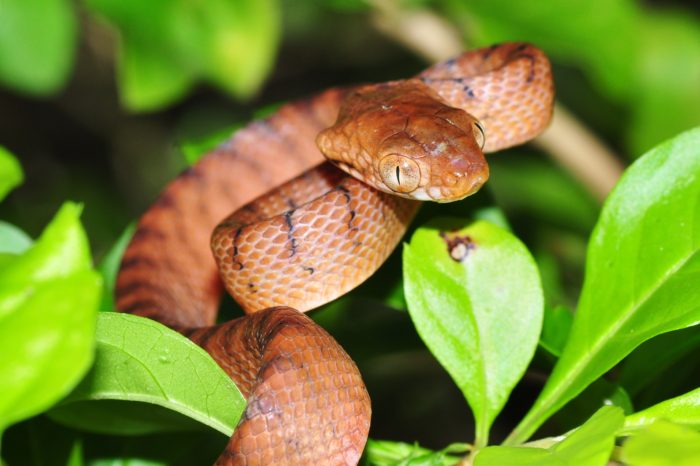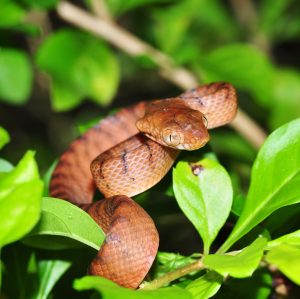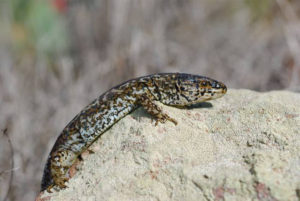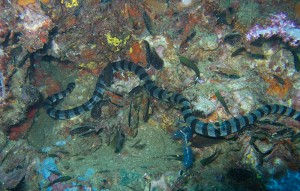Disappearing Snakes
Thanks to long-term data sets, scientists have been able to document the fact that a snake community plummeted following the wipe out of frogs in Panama due to an invasive fungal pathogen.
 Image: Pavel Kirillov from St.Petersburg, Russia [CC BY-SA 2.0 (https://creativecommons.org/licenses/by-sa/2.0)], via Wikimedia Commons
Image: Pavel Kirillov from St.Petersburg, Russia [CC BY-SA 2.0 (https://creativecommons.org/licenses/by-sa/2.0)], via Wikimedia Commons A study led by Michigan State University and University of Maryland should sound yet more alarm bells regarding the biodiversity crisis and the loss of wildlife around the world.
The loss of any species is devastating. However, the decline or extinction of one species can trigger an avalanche within an ecosystem, wiping out many species in the process. When biodiversity losses cause cascading effects within a region, they can eliminate many data-deficient species – animals that have eluded scientific study or haven’t been researched enough to understand how best to conserve them.
“Some species that are rare or hard to detect may be declining so quickly that we might not ever know that we’re losing them,” said Elise Zipkin, MSU integrative biologist and the study’s lead author. “In fact, this study is less about snakes and more about the general loss of biodiversity and its consequences.”
Snakes may not be everyone’s favourite animal and are frequently feared or hated (usually because of misunderstanding or ignorance), but they play a crucial role in their ecosystems and are deserving of our protection.
In most ecosystems, snakes can be both predator and prey. When a large prey population attracts and sustains a large snake population, those snakes in turn become prey for birds, mammals and even other snakes. Some snakes specialise in preying on other snakes, like the kingsnake, which can prey on rattlesnakes because they are immune to rattlesnake venom.
As predators, snakes often keep prey populations in check. These are often pest species, such as rodents that can cause millions of pounds worth of damage in human environments. Snakes are free pest controllers and, unlike chemicals, are environmentally-friendly. In many cultures, snakes are also revered and celebrated. They are often viewed as good fortune and some societies believe that the snake created the world.
However, snakes are seriously under threat. Some snake species have become threatened due to habitat destruction, urban development, disease, persecution, unsustainable trade and through the introduction of invasive species. Many snake species are endangered and some species are on the brink of extinction.
The snakes in question in this study (published in Science) reside in a protected area near El Copé, Panama. The new study documents how the snake community plummeted after an invasive fungal pathogen wiped out most of the area’s frogs, a primary food source. Thanks to the University of Maryland’s long-term study tracking amphibians and reptiles, the team had seven years of data on the snake community before the loss of frogs and six years of data afterwards.
Yet even with that extensive dataset, many species were detected so infrequently that traditional analysis methods were impossible. To say that these snakes are highly elusive or rare would be an understatement. Of the 36 snake species observed during the study, 12 were detected only once and five species were detected twice.
“We need to reframe the question and accept that with data-deficient species, we won’t often be able to assess population changes with high levels of certainty. Instead, we need to look at the probability that this snake community is worse off now than it used to be,” Zipkin said.
Using this approach, the team, which included former MSU integrative biologists Grace DiRenzo and Sam Rossman, built statistical models focused on estimating the probability that snake diversity metrics changed after the loss of amphibians, rather than trying to estimate the absolute number of species in the area, which is inherently difficult because snakes are so rare.
Zipkin says: “We estimated an 85% probability that there are fewer snake species than there were before the amphibians declined. We also estimated high probabilities that the occurrence rates and body conditions of many of the individual snake species were lower after the loss of amphibians, despite no other systematic changes to the environment.”
When animals die off en masse, such as what is happening with amphibians worldwide, researchers are dealing mainly with that discovery and are focused on determining the causes. But what happens to everything else that relies on those animals? Scientists don’t often have accurate counts and observations of the other species in those ecosystems, leaving them guessing to the consequences of these changes. The challenge is exacerbated, of course, when it involves rare and data-deficient species.
“Because there will never be a ton of data, we can’t pinpoint exactly why some snake species declined while others seemed to do okay or even prospered after the catastrophic loss of amphibians.” Zipkin said. “But this phenomenon, in which a disturbance event indirectly produces a large number of ‘losers’ but also a few ‘winners,’ is increasingly common and leads to worldwide biotic homogenization, or the process of formally dissimilar ecosystems gradually becoming more similar.”
The inability to put their finger on the exact cause, however, isn’t the worst news to come from their results. The truly bad news is that the level of devastation portends to much greater worldwide loss than the scientific community has been estimating.
“The huge die-off of frogs is an even bigger problem than we thought,” said Doug Levey, a programme director in the National Science Foundation’s Division of Environmental Biology. “Frogs’ disappearance has had cascading effects in tropical food chains. This study reveals the importance of basic, long-term data. When these scientists started counting snakes in a rainforest, they had no idea what they’d eventually discover.”
Zipkin agrees that long-term data is important to help stakeholders ascertain the extent of the issue: “We have this unique dataset and we have found a clever way to estimate declines in rare species. It’s sad, however, that the biodiversity crisis is probably worse than we thought because there are so many data-deficient species that we’ll never be able to assess.”
On a positive note, the scientists believe that improved forecasts and modelling could lead to bolstering conservation efforts. Making data-driven, proactive changes can prevent massive die offs and curb biodiversity loss.





No comments yet.